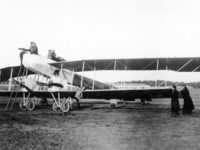The Gotha G.I was the first large combat aircraft of the Gothaer Waggonfabrik, whose subsequent bombers were to become the most famous aircraft of the German Empire during the First World War and bombarded cities in Great Britain for the first time.
Development and construction:
From 1912, the Gotha Waggonfabrik started to build aircraft. Initially, these were single- and double-decker aircraft used for training and as seaplanes.
Under the direction of engineer Carl Oskar Ursinus the first large aircraft was developed at the end of 1914, which was initially intended as a seaplane. The special feature of this was the atypical construction, as the upper wing was connected to the fuselage and the lower wing was attached throughout under the fuselage. Ursinus, who had patented this construction, justified this, that the shooter has a clear field of fire upwards and is no longer limited by the upper wing. Also, the close arrangement of the engines, should serve that in case of failure of one of the engines, the aircraft should still be able to perform an emergency landing.
The prototype first flew in early 1915, but this was still equipped with two Benz Bz II, each with 100 hp. In the later version, two Benz Bz III were installed with 150 hp.
A total of 18 pieces were built by this bomber, due to the low speed and the insufficient bomb load of 150 kg, these were not built in larger numbers.
Use in the First World War:
In mid-1915, the first Gotha G.I was brought to the front and used. In the fall of 1915 six bombers were in action at the same time, which meant the maximum number. After that, the aircraft were gradually withdrawn from the front and used for training.
In October 1916, finally, the last Gotha G.I was withdrawn, as these were considered outdated at the time.
Technical specifications:
| Designation: | Gotha G.I |
| Country: | German Empire |
| Typ: | Bomber |
| Length: | 12,9 meters |
| Span: | 22 meters |
| Height: | 3,9 meters |
| Mass: | 1790 kg empty |
| Crew: | Max. 3 |
| Engine: | Two liquid-cooled six-cylinder in-line engines Benz Bz III with each 150 hp |
| Maximum speed: | 130 km/h |
| Reach: | 540 kilometers |
| Armament: | 1 - 2 x 7,92 mm Parabellum LMG 08/15 machine guns and up to 150 kg bombs |
You can find the right literature here:
Fokker Dr I Aces of World War 1 (Aircraft of the Aces)
Undoubtedly the most famous fighter type to see service on either side during World War 1, the Fokker Dr I was a revelation when it entered service on the western front in 1917. Manfred von Richthofens JG 1 circus was the first Jasta to completely re-equip with the new fighter, and in the skilled hands of its numerous aces the Dr I proved a formidable opponent. The Dr I remained in service on the Western Front until replaced by the superior Fokker D VII in May 1918. Just weeks prior to that, however, Germanys leading ace, the great Red Baron, had been killed at the controls of a Dr I.
Friedrichshafen Aircraft of WWI: A Centennial Perspective on Great War Airplanes (Great War Aviation) (Volume 21)

Friedrichshafen Aircraft of WWI: A Centennial Perspective on Great War Airplanes (Great War Aviation) (Volume 21) Paperback – February 16, 2016
This book describes and illustrates the development of Friedrichshafen aircraft of WWI with text, 540 photos, 18 in color, 37 color profiles, production quantities and serial numbers of aircraft, and aircraft dimensions and performance specifications. In addition, there are 26 official SVK drawings and 11 aircraft are illustrated in scale drawings to 1/48 (4) or 1/72 (7) scales. The book has 312 pages and is of interest to aviation historians, enthusiasts, and modelers alike.
German and Austro-Hungarian Aircraft Manufacturers 1908-1918
Much has been written about the British aircraft of the First World War, but little has surfaced about the aircraft of the Axis powers, Germany and Austria. Here, Terry C. Treadwell tells the story of the aircraft from companies such as Fokker, builder of the famous triplane, as fl own by Baron von Richthofen's Flying Circus, AEG, Albatros, Junkers and Hansa. From reconnaissance aircraft to state-of-the-art bombers that could reach London, this is the definitive guide to aircraft of the Axis powers during the First World War. The aircraft are explained in detail and a history of each company is provided, making this an excellent source book for aircraft enthusiasts, model makers and those interested in the air war over the trenches of France and Belgium, as well as further afield in the Italian campaign.
The Zeppelin in Combat: A History of the German Naval Airship Division
The standard reference now revised and expanded. Dr. Robinson has opened up his vast photo archives to enhance this new edition of his classic work. Much of the new photographic material is published here for the first time.
This post is also available in:
 Deutsch (German)
Deutsch (German)  Français (French)
Français (French)  Italiano (Italian)
Italiano (Italian)  简体中文 (Chinese (Simplified))
简体中文 (Chinese (Simplified))  Русский (Russian)
Русский (Russian)  Español (Spanish)
Español (Spanish)  العربية (Arabic)
العربية (Arabic)
















